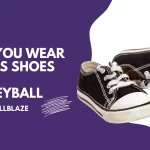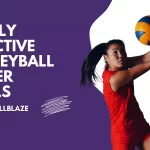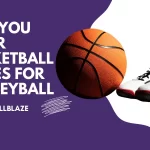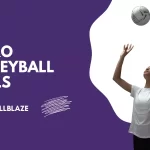Defender specialists (DS) are often confused with liberos in volleyball, and while these terms are similar, the real DS is completely different.
So, what is a defensive specialist in volleyball? Defensible specialists are experienced volleyball players who possess defense techniques and strategies separate from the libero role on the team. During tough matches, they are responsible for replacing weak players and bolstering their team’s defense and mental toughness.
As the DS volleyball position, you are probably not as familiar with this role as anyone else in volleyball, and that’s one reason why it is frequently overlooked.
One-man teams – or teams with a player capable of playing one – consistently perform better than their competitors at higher levels. In addition to their experience and leadership qualities, DS’s presence on the court also contributes to this.
History Of The Defensive Specialist (DS)

As with the libero, the defensive specialist probably emerged around 1999. By consistently passing and digging, the DS assisted the libero in the back row. Due to this position’s specialist nature, players can concentrate on plays and strategies that will make them more effective.
The player was referred to as a back-row player before this position was named. As soon as they reached the front row, they would switch with a front-row player. Back-row switching would be minimal until this and the libero positions were added. Because this position allows the player to focus on defense, the game of volleyball has become more exciting.
DS vs Libero: What’s the Difference?
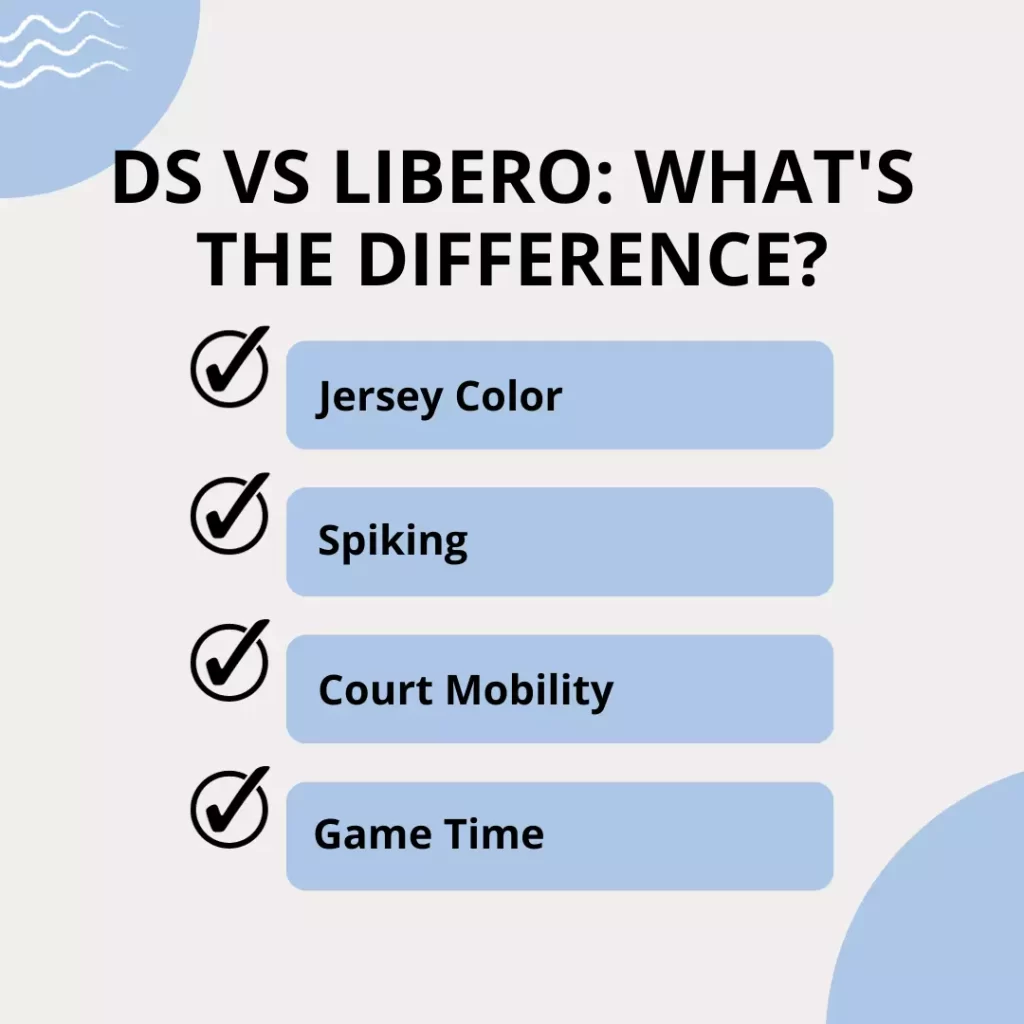
It is true that the libero is often called a “defensive specialist,” but they hold a highly specialized position with unique rules. Liberos sacrifice some abilities for flexibility, making the role of “defensive specialist” more dynamic.
Some teams, however, still employ DSs as positional leaders. Anyone who has a talent for defense can be this type of player, provided they have a lot of experience and knowledge of the game.
Between the DS and Libero, there are four key differences:
1. Jersey Color
In contrast to the libero, the DS does not wear a unique jersey. In addition, they participate in the game as a member of the team according to the regular rules, but they must use an official substitution to enter and leave the court. Normally, they are limited to one (or two, in the US) rotation per year.
2. Spiking
As opposed to the libero, who is prohibited from spiking or contacting the ball above the height of the net, the DS is not restricted by these restrictions.
DSs are often specialists at back-row spiking, which involves attacking from behind the 10-foot line. They can then focus on blocking if needed, strengthening the defense of their team in this area.
3. Court Mobility
In spite of the fact that they often rotate around the court for the whole back row rotation, the DS isn’t restricted solely to the back row. If left unsubscribed, they can rotate completely around the court. Liberos cannot play front row, unlike this.
This may be appropriate in some situations when the coach gives the spiker a break physically or mentally and gives the DS two rotations on the backcourt. Each team has its own strategy, but the DS offers options for each.
4. Game Time
It is easy to distinguish the libero with their off-color jersey since they are always present on the court. Fans and other teams pay attention to them throughout the game, tracking their positions. During a match, the libero is almost always on the court, regardless of the level of opposition.
On the other hand, the DS is the opposite. A libero is always on the court, but a DS only appears when his opponent is tough. As long as the opposing team can’t score, their job is to hold on to every point.
If this is not possible, the DS must help their team “side out” and rotate through their strongest hitters in order to get their team back to scoring.
It may be the case that the DS plays only five minutes in some matches. They may have lost their game without that small amount of time offered in most situations.
You may enjoy reading Volleyball Setter Drills
Are Defensive Specialists and Liberos Necessary for Teams?
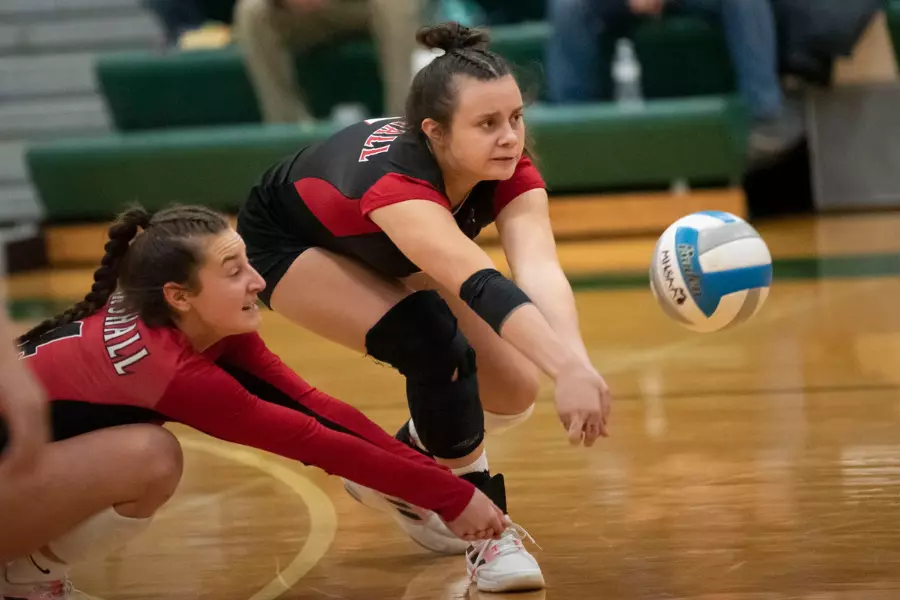
It is a great team effort between the DS and Libero that creates such a strong backcourt. The other 4 players are free to focus on offense during entire rallies when those 2 players are on the back row.
Is A DS A Good Position To Play In Volleyball?
In volleyball, the DS is a great position to play. Defense specialists normally come on at critical moments – or sometimes to help a specific player – rather than liberos, who play the ball more often than others.
Playing as a spiker can be as exciting as being a spiker because they are trusted to dig the team out of trouble.
As a DS, you must be adept at all skills, but defense is especially important.
With the libero, the DS is responsible for controlling the court with game sense and reliability, and since they often have experience and game knowledge, the DS is often one of the most respected players.
Although DS might not sound flashy when boiled down to defense, some of the most hyped plays begin with an epic reception. In the end, hitting a killer spike is easier than passing one. It is the DS’ presence that makes the setter’s presence known, whether passing, diving, picking up the block-touch, or covering for him.
The DS can spike as well, unlike the libero! The DS is known for its back-row attacks, which are more inconsistent than those made by most spikers.
Some players are concerned about not getting enough court time when they play DS.
Truthfully, there are some games where you won’t leave the bench as a DS, due to a good passing day or difficulty putting up an offense from the opposing team. Disappointment can result from that. There will be a time for you.
The amount of time you play doesn’t determine your worth; the impact you make does. The DS volleyball position with the highest impact-to-time ratio.
You may enjoy reading What is a Kill in Volleyball
Do You Need A Defensive Specialist?
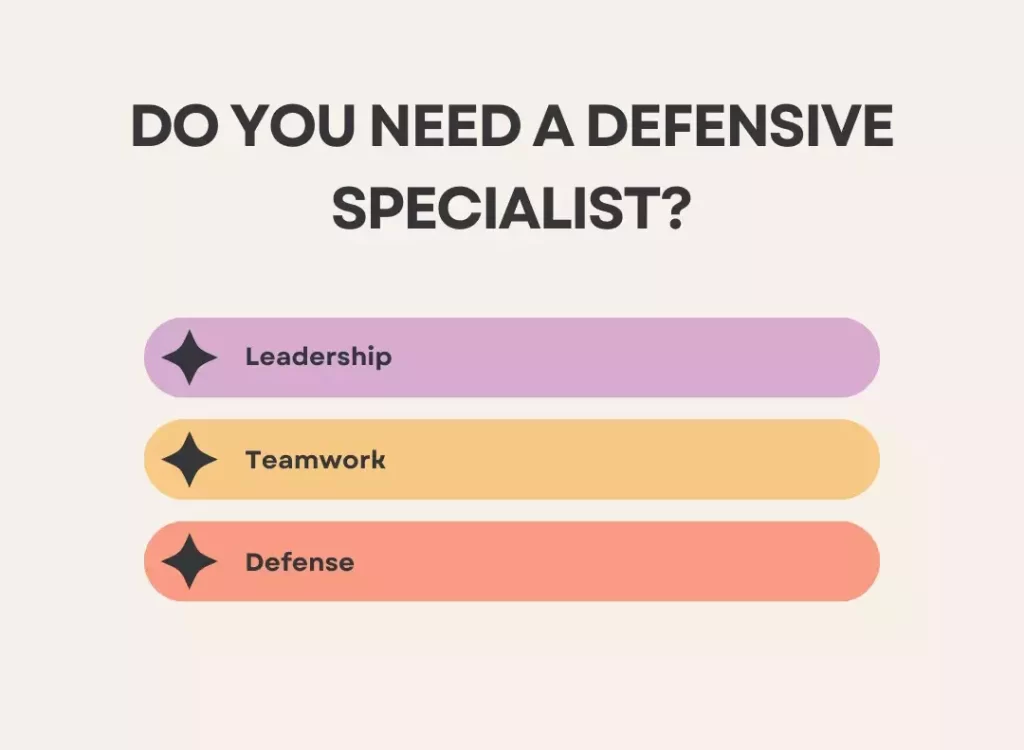
In spite of the fact that it is not technically “necessary” for a team to have a defensive specialist, I believe that any team that does have one will both perform and develop better over the long run. Before selecting or passing over a DS, a coach should take into account all of the DS’s roles on a team.
Teams should have a DS for the following reasons:
1. Leadership
Team members often look up to a DS as a role model. In addition to setting a good example, they should also coach and guide the younger players to become an asset to the team as they continue to grow as players.
Despite being an accomplished player, the DS is rarely glamorous due to the nature of the position. When things get tough, they use their sense of self-worth to calm their teammates and keep their heads in the game.
DS players often take on leadership roles within their teams, which is why they tend to be captains or vice-captains. DS players are often turned into great coaches in the future.
2. Teamwork
It is often easier to work together when you have a DS. They are able to make the right calls with their impressive knowledge of the game, earning them the trust and respect of their teammates. Having this trust from their teammates helps them to work together more effectively and commit themselves completely to a play.
During games, some teams implement “row-captains” in the front court and the backcourt, who lead practice sessions and are responsible for the team’s wellbeing. Normally, these players are specialist players assigned to lead defense in order to facilitate better teamwork.
The middle blocker is usually designated as the “blocking captain” on the front court. Similarly, the DS (or libero in the absence of the DS) is often the player on the backcourt.
3. Defense
Their defensive skills are enhanced with the DS on a physical level. Their positive mentality helps them turn hopeless points into victories by keeping the ball in play. A testament to their dedication to the sport of volleyball is their rock-solid mentality and experience.
In some cases, DSs have played outside or libero during their volleyball careers before transitioning to DS. The reason for this is not that their teammates have surpassed them, but because their expertise is essential for this position. Due to their years of defensive experience in other roles, they are able to sub right away when needed.
It’s like having a second libero on the court when you have two defensive specialists on the court at once, so the opposing team has to do twice as much work.
Rules Of The Defensive Specialist
In the back row, the defensive specialist passes, digs, and saves the ball. Keeping the ball in play for their team requires following some rules when playing this position. These rules are listed below.
- Defensive Specialists can only be substituted in. Usually, they replace a player from the front row.
- The Defensive Specialist can start. Unlike the libero, who must come in after the referee checks the lineup, the defensive specialist can start the game.
- After the serve, the defensive specialist can switch back. After the server has left the court, the DS can switch positions on the court.
- Defensive Specialist jumps and swings. If a DS is behind the 10-foot line, he or she can jump and hit the ball, unlike the libero.
- Defend Specialists can serve. In the case of a DS who replaces a player who has not served in the rotation, the DS can serve when they enter the game.
- A defensive specialist can retrieve a ball out of the court. The DS can go out of the court to save the ball if the ball is hit out of bounds on a first or second hit.
A defensive specialist (DS) must follow the following rules while on the court. For more information, visit USA Volleyball.
Responsibilities And Skills Of The Defensive Specialist

Defensive specialists in volleyball are responsible for a wide range of skills and responsibilities. These responsibilities and skills will be discussed in this section.
Responsibilities
It is important for the success of the team for the DS to fulfill five important responsibilities.
- Serve receive
- Digging
- Passing
- Covering players
- Teamwork
Serve Receive
It is imperative for a defensive specialist to be able to pass the ball well during serve receives. It doesn’t feel good to get aced or shanked for their teammates to scramble after. The DS must adjust to receive the next serve successfully if the serves are difficult to receive.
To be a successful DS, it is essential that he/she practices receiving serves and passing with the correct technique. In order for them to work together effectively, they must communicate what areas they need to cover with the libero in the back row.
As soon as a ball comes over the net, the DS will cover it, whereas the libero will cover it at the back.
Digging
When the opposing team hits the ball over the net, the DS is responsible for digging it out. It is crucial for the DS to read the hitter in order to predict where the ball will go on the court. Getting into position quickly and staying low is essential once they know where the ball is going.
It is important for them to always face the direction where the ball should be passed. Digging is a skill that requires a lot of practice, so if you want to become a successful defensive specialist, you have to practice the right techniques often.
Passing
Defensive specialists are primarily responsible for passing. In order to pass the volleyball effectively, they need to have good ball control and be focused. For good ball control, they must use techniques like flat platforms with their arms, good body positions, knees bent, and good posture.
Defense specialists and liberos work closely together, so they need good communication skills.
They will have great success if they are able to get into a rhythm in back row together. As well as giving each other encouragement, these two players usually discuss what areas they need to cover.
Covering Players
The defensive specialist is also responsible for getting into position to cover other players. If a ball is blocked or returned quickly back over the net, the DS should move up to cover the ball. DS can anticipate where they need to cover if they are reading the player’s opposite of the net.
By the way, when the DS approaches a ball, they may be able to determine if the ball will go downline, short, or crosscourt if it is set to the outside hitter. When the DS notices something, he or she can call it out to the other players. Defense becomes easier for the whole team when this is done.
Teamwork
The defensive specialist must work closely with his teammates no matter what position he plays in volleyball. Teammates will trust a DS more on the court if they have a good relationship with them.
Communication between the DS and the other players is important since he can often see what is coming from the other side of the net. You can also gain trust by moving quickly and attempting to get to the ball as soon as possible.
It is imperative that the DS do everything they can to keep the ball airborne. Their team will know they are contributing to teamwork when they do this.
Skills
It is necessary for a defensive specialist to possess certain skills in order to carry out their duties. These skills are listed below.
- A consistent player makes accurate passes most of the time, the ball doesn’t hit the floor very often, and the ball is always in the right place to cover the court.
- Experience knows where to be on the court to cover the ball at all times
- Taking hits from opposing hitters after a bad pass or dig, regaining endurance quickly
- Working with teammates on the court requires effective/positive communication skills
- No matter if they don’t get the ball, keep trying
- The ball must not be shanked too often by an efficient passer/digger
- An aggressive player doesn’t hesitate to go for the ball when it’s time to play, calls out for the ball when he’s ready to play
Defensive Specialist Drills

1. Role Flexibility Drill
It is best to have them play different roles during practice scrimmages in order to train flexibility and further their knowledge of the DS game.
DS should replace a member of the back row every week. Before switching them out again, complete one full rotation. DS should be switched to the other side (preferably in a different role) and play continued. Continue until the set or scrimmage is over.
In this drill, the DS will be thrust into constantly changing situations within various teams, in order to become familiar with switching positions quickly and often.
A DS must adapt quickly to different team members and positions in order to be effective, just as a real match is stressful and chaotic. Mental toughness is also developed by forcing them to compete against their own points.
During the DS’s entrance and exit from the court, coaches need to keep track of their side’s points. It would be better if they could assist their team in securing more points. If your DS doesn’t finish their rotation by the end of the set, take note of the players on the court: you’ve got an impressive lineup.
2. Deep Passing Drill
It is typically the DS who fills in for the outside in position six instead of the libero, who plays position five. In other words, they must drill appropriately so that deep balls can be returned.
This drill requires your players to stand alongside the 10-foot line on the sidelines. The setter must catch the pass at the setter’s position by slapping the ball and throwing it high and deep over the net.
The static setter should pass the ball to the player after the slap. The second ball must be thrown short so the players must scramble to pick it up and join the end of the first ball. To get players’ blood pumping, this is a good warmup drill that emphasizes quick footwork and pace.
In those deep situations in-match, the DS needs lateral mobility both to chase a ball and return it to the setter, not just accuracy in passing. Your other back-row players and even your setter will benefit from this as well.
For stamina conservation, follow this drill with a more technical one using a timer or point system.
3. Spiking Drill: Back Court
A net is the best tool for practicing spiking. Start by downballing from behind the ten-foot line, then toss it to yourself when you feel comfortable doing it. Keep the ball in bounds and spike as close as you can to the ten-foot line.
You should shift your hitting lines with your teammates to accommodate spiking from the back row. Using a teammate to film you from the sidelines is by far the best approach to practicing this kind of technique.
If you don’t have a net, try to find a friend or a wall. Downball to them while focusing on your spike’s arc and spin, similar to solo work with a net. Rather than bouncing the volleyball, try catching it instead, to mimic the extra distance required to cross the net.
You can only reach a certain level of spiking without a net, as with other levels. Arrange to practice back row spiking during practice with your coach or captain. You will feel awkward attempting this during a match, so practice beforehand!
You may enjoy reading Volleyball Rotations
What Does the DS Position Mean In Volleyball
DS stands for defensive specialist in volleyball. On a volleyball team, this role is one of many, including setter, middle blocker, outside hitter, opposite hitter, and libero.
It is important for defensive specialists to have sound passing skills and excellent digging abilities. There are two roles in the volleyball team focused on ball control: libero and DS. A great pass should be the first thing they do on every play.
Consistency is one of the hallmarks of a defensive specialist. Their strengths lie in providing consistent good passes during serve receive, in digging, and in providing good defensive coverage. They may also be adept at serving as well.
Defensive specialists are also the players who make the impossible saves by scrambling for each ball. For them to be in the right place at the right time, they must have great reflexes and an ability to read the other team’s offense.
Why Defensive Specialists Are Tough
As an athlete, you receive constant feedback from your coach. It will hopefully be constructive and encouraging. We expect to receive additional instructions or criticism if we make a mistake.
Coaches have less to criticize when it comes to DS and liberos, so they are less likely to praise them. This role requires you to be right or wrong, regardless of whether you are right. Making the first contact correctly is crucial every time you cross the net.
In order for a player to make up for his mistakes, he or she must understand that every other player has offensive opportunities to score points. Although coaches and teammates should encourage defensive players just as much as offensive players, I just want to point out that this is not the practice.
Thus, I consider the libero and DS to be the most thankless positions on the team.
5 Characteristics of the DS Position in Volleyball

As I’ve already mentioned, the DS has many characteristics that make it great. However, the following list should be a guide for anyone interested in what it takes to excel as one, or for any coaches looking to train their players accordingly.
In my opinion, these are the five characteristics that make a great DS, while not all of them are necessary to succeed.
1. Perfect Touch
The DS should have a “perfect touch” as a defensive specialist. Having the perfect first touch to make the ball go where you want it to go is a huge advantage in volleyball, a game of instants – touches on the ball without catching it.
Drills and exercises can be used to train this perfect touch, but experience plays just as big a role.
It has also been championed by coaches around the world that visualization plays a huge role in developing this defensive touch. Bill Stobie, head coach, explains:
“Experienced defensive players must visualize the perfect ball flight in order to play a defensive touch. When the ball is intercepted, the brain systems do not see the ball’s flight, they predict where the ball will end up based on the initial flight information. In order to have the ball rebound at an angle that will send the ball in an arc to where they imagine it will go, their body and arms move to intercept the ball. Depending on your desire for that perfect flight, your brain works out the necessary adjustments in the background. The chances of you getting that perfect ball in are lessened if you don’t visualize it. Try it – it works!
Currently, Bill Stobie serves as the head coach and team manager of the Scottish Student Sports Representative Team. He is also the head coach and team manager of NUVOC Volleyball Club.
A great DS needs to have the perfect first touch, which can be learned with visualization, training, and experience.
2. Game Knowledge
Game knowledge must also be a key component of a great DS. In addition to watching pro matches and attending skill clinics, volleyball players often accumulate this through years of playing in different leagues, matches, and tournaments.
There are two types of game knowledge: first, the entire set of rules for volleyball; and second, the correct responses to certain situations.
It is essential for DSs to be familiar with specific rules, such as the rules for reaching across nets, rotational faults, and screening.
They can confidently perform combos without breaking any rules by understanding these and more. The DS can also prevent their teammates from using their feet out of place and causing the team to lose points.
Additionally, with DS game knowledge, they will be able to identify the serving seam, read spikes and feints, and pass the ball where the setter can best capitalize on it.
The main role of a DS is to pick up junk: tips from the block, heavy swings from the middle blocker, and hard angles from outside hitters. An effective DS can adjust to the opponent’s offense, anticipate moves, and pass non-hard-driven balls in a way that runs the best offense for the team.
University of St Andrews DS 2016-2020 Luca Jordano
In this way, the opposing team has to work harder, while their own team is reassured that there’s no magic involved, only hard work.
3. Flexibility
Since the DS is meant to replace a struggling back-row player on any given day, it is impossible to predict who that player might be. Depending on the situation, it could be an outside, opposite, or even a middle (if the libero has a bad day and needs to leave the court as well). The DS may even replace the setter in rare cases.
In short, DSs must possess the greatest degree of flexibility. Furthermore, they must understand how they move on court and their individual roles as well as the differences in defending each role. New players may find this extremely challenging, which is why experienced players usually handle the DS.
It is also possible for the DS to fill in during a match for a player – usually outside. As a result, or if the coach makes a sudden substitution, they must adapt quickly and play at a high level immediately. It can be exciting and fun, but it can also be very challenging.
4. Solid Mentality
The mental state of a DS while playing must be absolutely solid. In addition to its physical elements, volleyball is a highly mental sport, so players can get emotionally affected by extreme highs and lows, but the DS cannot.
As one of the team’s respected members, their teammates will mirror their reactions on the court. When faced with challenges, staying cool ensures they play their best and contribute to the team’s collective mentality.
Furthermore, the DS often comes into play when the team is down in points. Dwelling on the difference is depressing, and thinking negatively will not help. It is vital for the DS not to become emotionally involved in this situation, or else their impact will be greatly diminished.
The DS is a great role model for volleyball players to learn about having a strong mentality.
5. Back Row Attacker
It may surprise you to learn that a great defensive specialist is also a proficient back-row attacker. As a result, the setter will have another reliable alternative to constantly setting the outside, and the team will have another method of earning points.
When practicing your back-row attacks, don’t focus on training your DS harder than the outsides.
As a DS, your role is to provide an unpredictable barrage of accurate shots that force the other team to react. To avoid spiking out or in the net, the DS should target tricky zones on the court based on their own knowledge of the defense.
Although you should score some points, the primary objective is to distract the defender’s attention and weaken their defense.
Defensive Specialist Equipment
A defensive specialist must be able to move quickly on the court while passing to the setter and controlling the ball well. During a great play, they help their team set up. Equipment plays an important role in assisting them in their success.
Our top picks of defensive specialist equipment will be shared in this section.
Shoes
Nike Womens Zoom Hyperace 2

Comfort, flexibility, and durability are all essential qualities in volleyball shoes for defensive specialists due to their quick movements.
It’s great for a defensive specialist to wear the Nike Women’s Zoom Hyperace 2. Specially designed for hard courts, these shoes provide a high level of protection. In addition to providing excellent cushioning, they have arch support to keep feet comfortable. Due to their lightweight material, they are very flexible on the court for those quick movements.
Rubber soles and excellent traction are included in the design of these shoes. In order to prevent injuries to defensive specialists, they need traction on the court to prevent them from sliding. The shoes also feature a heel cage on the back to enhance stability and support.
Knee Pads
Mizuno LR6 Volleyball Knee Pads
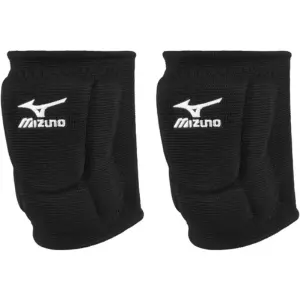
The defensive specialist needs knee pads as part of their equipment. It is important for them to have kneepads that provide comfort and protection while they go to the ground to save the ball. Here are our top picks for knee pads for defensive specialists.
A Mizuno LR6 knee pad provides great coverage while allowing freedom of movement for the defensive specialist. By padding high impact areas on these knee pads, they provide incredible knee support. In addition to patella protection, they also provide lateral and medial protection. In addition to providing premium breathability, the intercool ventilation system also circulates air efficiently.
Mizuno specializes in volleyball equipment, so it’s no surprise they are the top company for comfortable and durable knee pads. They have invested a lot of time and energy into researching and testing knee pads of high quality. Wearing these knee pads makes some people feel like they’re not even wearing anything.
Frequently Asked Questions
Are Ds and Libero the Same Thing?
No. It is true that liberos are often referred to as “defensive specialists”, but their positional role belongs to a DS with his own strategies and purposes. Liberos and DSs, however, can be referred without issue, since both are defensive experts.
What Does Ds Stand for in Volleyball?
In volleyball, DS stands for “defensive specialist.” Defensive specialists are highly skilled and strategic players who can fill in for any team member. With the DS, a team can improve its defense and shorten/lengthen its leads as needed. Their experience and ability to make the right decisions make them one of the most trusted players on the court.
What’s the average size/height of a defensive specialist?
As DSs can come in any height, they will vary quite a bit in height.
Middle blockers seldom play DS roles, since they rarely pass, and opposite hitters are no different.
Outside hitters or setters are more likely to enter the court as DSs, so they are typically of average or short height.
Is a defensive specialist a blocker in volleyball?
If your team needs the biggest blocking presence it can muster, you can be subbed into the front court.
However, DS can be a blocker very often.
DS usually sits in the back row and passes the ball most of the time.
How many defensive specialists are there in volleyball?
There’s nothing stopping you from having more than one DS on a team.
The defensive specialist is just a player who is substituted in to assist with a specific task (usually passing the ball).
There is a possibility of having several players who can fulfill the role of DS.
Conclusion
DSs are defensive specialists on the court who dig and save balls from the back row. When blocking or hitting, they also need to back up the front row. Watch a volleyball match the next time and notice how the DS plays each role.
You should practice passing and digging the volleyball if you want to become a defensive specialist. The drills listed above should also be practiced by watching others playing this position.
You may enjoy reading Volleyball Setter Workouts

